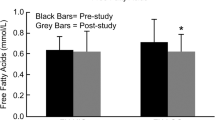Abstract
The purpose of this study was to evaluate the effectiveness of two exercise modalities for improving glycosylated hemoglobin (HbA1c) and associated clinical outcomes in Polynesian adults diagnosed with type 2 diabetes and visceral obesity. Twenty-six adults were randomized to receive resistance training or aerobic training, 3×/week, for 16 weeks. Dependent variables collected before and after intervention included: diabetes markers including HbA1c, blood lipids, relevant cytokines (C-reactive protein, adiponectin), and anthropometric and hemodynamic indices. Eighteen participants (72% female; age: 49.3 ± 5.3 years; waist circumference: 128.7 ± 18.7 cm) completed the intervention and follow-up assessments. Body mass index in the whole cohort at baseline indicated Class III (morbid) obesity (43.8 ± 9.5 kg/m2). Compliance to training was 73 ± 19 and 67 ± 18% in the aerobic and resistance training groups, respectively. HbA1c remained elevated in both groups after training. Aerobic training reduced systolic and diastolic blood pressure and increased serum triglycerides (all P < 0.05). No other exercise-induced adaptations were noted within or between groups. Post hoc analysis using pooled data indicated that higher adherence to training (≥75% attendance, n = 8) significantly reduced waist circumference (P < 0.001) and tended to reduce body weight and fasting insulin (all P ≤ 0.11) versus lower adherence (<75% attendance, n = 10). In conclusion, this study did not demonstrate an improvement in HbA1c with exercise in morbidly obese Polynesian people. Future investigations involving exercise regimens that are more practicable and which involve greater frequency and duration of training may be required to induce significant and clinically meaningful adaptations in this unique diabetes population.

Similar content being viewed by others
References
Abate N, Chandalia M (2003) The impact of ethnicity on type 2 diabetes. J Diabetes Complicat 17(1):39–58
Albright A, Franz M, Hornsby G, Kriska A, Marrero D, Ullrich I et al (2000) Exercise and type 2 diabetes. Med Sci Sports Exerc 32(7):1345–1360
Baldi J, Snowling N (2003) Resistance training improves glycaemic control in obese type 2 diabetic men. Int J Sports Med 24(6):419–423
Bramley D, Hebert P, Jackson R, Chassin M (2004) Indigenous disparities in disease-specific mortality, a cross-country comparison: New Zealand, Australia, Canada, and the United States. N Z Med J 117(1207):U1215
Castaneda C, Layne J, Muñoz-Orians L, Gordon P, Walsmith J, Foldvari M et al (2002) A randomized controlled trial of resistance exercise training to improve glycemic control in older adults with type 2 diabetes. Diabetes Care 25(12):2335–2341
Diabetes New Zealand (2008) Diabetes Fact Sheet. Retrieved [Accessed 2009 July 26] http://www.diabetes.org.nz/__data/assets/pdf_file/0006/2301/Microsoft_Word_-_Diabetes_Fact_Sheet_2008.pdf
Diabetes Trials Unit (2007) Homa Calculator. 2008, from http://www.dtu.ox.ac.uk/index.php?maindoc=/homa/index.php
Dunstan D, Daly R, Owen N, Jolley D, De Courten M, Shaw J et al (2002) High-intensity resistance training improves glycemic control in older patients with type 2 diabetes. Diabetes Care 25:1729–1736
Grundy S, Brewer H, Cleeman J, Smith S, Lenfant C (2004) Definition of metabolic syndrome: report of the National Heart, Lung, and Blood Institute/American Heart Association Conference on Scientific Issues Related to Definition Arteriosclerosis. Thromb Vasc Biol 109:433–438
Kriketos A, Gan S, Poynten A, Furler S, Chisholm D, Campbell L (2004) Exercise increases adiponectin levels and insulin sensitivity in humans. Diabetes Care 27(2):629–630
Lindsay R, Bennett P (2001) Type 2 diabetes, the thrifty phenotype—an overview. Br Med Bull 60:21–32
McAuley K, Williams S, Mann J, Walker R, Lewis-Barned N, Temple L et al (2001) Diagnosing insulin resistance in the general population. Diabetes Care 24(3):460–464
McAuley K, Williams S, Mann J, Goulding A, Murphy E (2002) Increased risk of type 2 diabetes despite same degree of adiposity in different racial groups. Diabetes Care 25(12):2360
McAuley K, Murphy E, McLay R, Chisholm A, Story G, Mann J et al (2003) Implementation of a successful lifestyle intervention programme for New Zealand Maori to reduce the risk of type 2 diabetes and cardiovascular disease. Asia Pacific J Clin Nutr 12(4):423–426
Misra A, Alappan N, Vikram N, Goel K, Gupta N, Mittal K et al (2008) Effect of supervised progressive resistance exercise training protocol on insulin sensitivity, glycemia, lipids, and body composition in Asian Indians with type 2 diabetes. Diabetes Care 31(7):1282–1287
Pearson T, Mensah G, Alexander R, Anderson J, Cannon R, Criqui M et al (2003) Markers of inflammation and cardiovascular disease. Application to clinical and public health practice: a statement for healthcare professionals from the Centers for Disease Control and Prevention and the American Heart Association. Circulation 107:499–511
Price W (1939) Nutrition and physical degeneration. Price-Pottenger Nutrition Foundation, La Mesa
Rice B, Janssen I, Hudson R, Ross R (1999) Effects of aerobic or resistance exercise and/or diet on glucose tolerance and plasma insulin levels in obese men. Diabetes Care 22:684–691
Rush E, Freitas I, Plank L (2009) Body size, body composition and fat distribution: comparative analysis of European, Maori, Pacific Island and Asian Indian adults. Br J Nutr 102:632–641
Shenoy S, Arora E, Jaspal S (2009) Effects of progressive resistance training and aerobic exercise on type 2 diabetes in Indian population. Int J Diabetes Metabol 17:27–30
Sigal R, Kenny G, Boulé N, Wells G, Prud’homme D, Fortier M et al (2007) Effects of aerobic training, resistance training, or both on glycemic control in type 2 diabetes. Ann Intern Med 147:357–369
Simmons D, Thompson C (2004) Prevalence of the metabolic syndrome among adult New Zealanders of Polynesian and European descent. Diabetes Care 27(12):3002–3004
Simmons D, Gatland B, Leakehe L, Scragg R (1994) Prevalence of known diabetes in a multiethnic community. N Z Med J 107:219–222
Stannard S, Johnson N (2003) Insulin resistance and elevated triglyceride in muscle: more important for survival than ‘thrifty’ genes? J Physiol 554(3):595–607
Stannard S, Johnson N (2006) Energy well spent fighting the diabetes epidemic. Diabetes Metabolism Research and Reviews 22:11–19
Sykes K, Yeung T, Ko G (2004) A 12-week prospective randomized controlled trial to investigate the effects of aerobic training on type 2 diabetes patients. Am J Recreat Therap 3:36–42
Van Rooijen A, Rheeder P, Eales C, Becker P (2004) Effect of exercise versus relaxation on haemoglobin A1c in black females with type 2 diabetes mellitus. Q J Med 97:343–351
Winnick JGT, Schuster D (2008) Resistance training differentially affects weight loss and glucose metabolism of White and African American patients with type 2 diabetes mellitus. Ethn Dis 18(2):152–156
Acknowledgments
This study was supported by a Massey University Research Fund grant. We wish to thank all the participants for their hard work and dedication and without whom this study would not have been possible. We wish to thank Porirua City Fitness for providing the host venue, and ongoing staff and resource support for the study, Capital and Coast District Health Board for providing physical hospital resources and clinical staff support, and Roche Diagnostics for providing Accu-Chek blood glucose meters. We are also grateful to Kitiona Tauira, Pastor Teremoana Tauira, Pastors Ken and Tai Roach, Reverend Tavita Filemoni, National Heart Foundation, Pacific Health Services, Pacific Diabetes Society, Ora Toa Health Services, Waitangirua Pharmacy, Waitangirua Health Centre, Maraeroa Health Clinic, Whitby doctors, Titahi Bay doctors, and Newlands Medical Centre for their guidance and support from start to finish. We thank our on-site exercise leaders Amy Doyle, Steve French, Moana Jarden-Osborne, Bevan Kahui, Shelly Mather, Mike Ritete, and Mike Toe Toe for their diligent supervision and assistance, all of which maximized participant safety.
Conflicts of interest
None.
Author information
Authors and Affiliations
Corresponding author
Additional information
Communicated by Susan A. Ward.
Australian Clinical Trials Registry #: 12609001085268.
Rights and permissions
About this article
Cite this article
Sukala, W.R., Page, R., Rowlands, D.S. et al. South Pacific Islanders resist type 2 diabetes: comparison of aerobic and resistance training. Eur J Appl Physiol 112, 317–325 (2012). https://doi.org/10.1007/s00421-011-1978-0
Received:
Accepted:
Published:
Issue Date:
DOI: https://doi.org/10.1007/s00421-011-1978-0




